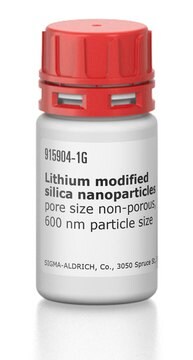Wichtige Dokumente
930903
Lithiumhydroxid Monohydrat
battery grade, ≥99.9% trace metals basis
Synonym(e):
Lithine hydrate, Lithium hydroxide hydrate
About This Item
Empfohlene Produkte
Qualitätsniveau
Qualität
battery grade
Assay
≥99.9% trace metals basis
Form
powder
Grünere Alternativprodukt-Eigenschaften
Design for Energy Efficiency
Learn more about the Principles of Green Chemistry.
sustainability
Greener Alternative Product
Verunreinigungen
≤1000 ppm (trace metals analysis)
mp (Schmelzpunkt)
423 °C
Löslichkeit
H2O: soluble ((lit.))
ethanol: slightly soluble ((lit.))
methanol: soluble ((lit.))
Anionenspuren
chloride (Cl-): ≤50 ppm
sulfate (SO42-): ≤50 ppm
Anwendung(en)
battery manufacturing
Grünere Alternativprodukt-Kategorie
SMILES String
[Li+].O.[OH-]
InChI
1S/Li.2H2O/h;2*1H2/q+1;;/p-1
InChIKey
GLXDVVHUTZTUQK-UHFFFAOYSA-M
Suchen Sie nach ähnlichen Produkten? Aufrufen Leitfaden zum Produktvergleich
Verwandte Kategorien
Allgemeine Beschreibung
Lithium hydroxide is produced in several ways. Most commonly, lithium carbonate is reacted with calcium hydroxide in a metathesis reaction. This directly yields lithium hydroxide hydrate, which is separated from the insoluble calcium carbonate byproduct and purified. Alternatively, when the source of lithium is spodumene ore, the ore can be converted to lithium hydroxide without first forming the carbonate. In the process, the lithium ore is treated with high-temperatures and sulfuric acid to form lithium sulfate; then the lithium sulfate is reacted with sodium hydroxide to form lithium hydroxide hydrate, which is purified.
Anwendung
Our battery grade lithium hydroxide monohydrate is well-suited for synthesis of nickel-rich metal oxides, like lithium nickel-manganese-aluminum oxide (NMA) and complex quaternary transition metal oxides like Zr-doped or Ti-doped nickel-manganese oxide.
Our lithium hydroxide monohydrate can also be used to synthesize lithium iron phosphates like LiFePO4 or lithium manganese oxides like Li2Mn2O4.
Signalwort
Danger
H-Sätze
Gefahreneinstufungen
Acute Tox. 4 Oral - Eye Dam. 1 - Skin Corr. 1B
Lagerklassenschlüssel
8A - Combustible corrosive hazardous materials
WGK
WGK 1
Flammpunkt (°F)
Not applicable
Flammpunkt (°C)
Not applicable
Hier finden Sie alle aktuellen Versionen:
Analysenzertifikate (COA)
It looks like we've run into a problem, but you can still download Certificates of Analysis from our Dokumente section.
Wenn Sie Hilfe benötigen, wenden Sie sich bitte an Kundensupport
Besitzen Sie dieses Produkt bereits?
In der Dokumentenbibliothek finden Sie die Dokumentation zu den Produkten, die Sie kürzlich erworben haben.
Global Trade Item Number
| SKU | GTIN |
|---|---|
| 930903-100G | 4065268960233 |
| 930903-1KG | 4065268960240 |
Unser Team von Wissenschaftlern verfügt über Erfahrung in allen Forschungsbereichen einschließlich Life Science, Materialwissenschaften, chemischer Synthese, Chromatographie, Analytik und vielen mehr..
Setzen Sie sich mit dem technischen Dienst in Verbindung.







